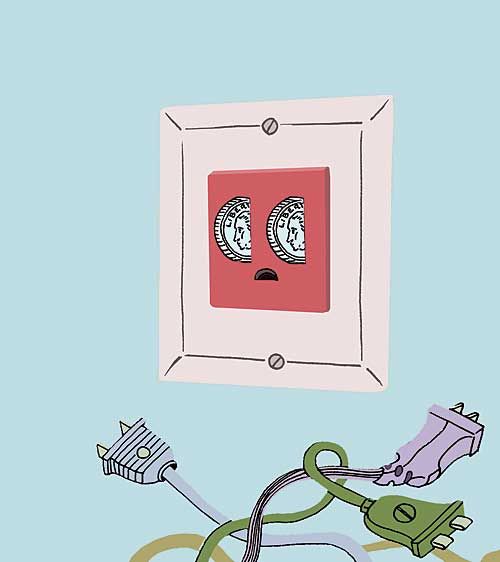New Year’s resolutions tend to be goals like quitting smoking, running some knee-crushing marathon, or writing that long-delayed memoir or mystery novel, all noble if daunting propositions. But resolutions don’t have to be just about you, pal. How about making this the year you start thinking about doing good for others, namely this pretty blue planet you’ve been sponging off of for so long? To inspire you, we’ve asked a few of our favorite ecoexperts and past contributors to the Green House column to suggest some easy ways you can lessen your household’s impact on the environment over the next 12 months.
1 ” Throw in the towel. You’re already buying paper towels made from recycled material, aren’t you? That’s a good first step. But once you use them, it’s landfill city. Americans go through about 2.5 million tons of quicker-picker-uppers annually. Danny Seo, host of the Sirius satellite radio program Simply Green, thinks 2007 is the perfect time to break that habit and start using microfiber towels instead. “They’re great for cleaning. They don’t scratch, they grip onto dirt and dust, and they’re washable and reusable,” he says. Super-absorbent, the cloths can hold up to six times their weight in water. One manufacturer, Method, offers towels formulated specifically for wood, granite, stainless steel, and glass.
2 ” Go on an energy diet. Peter Gang, energy-efficiency expert and principal of Common Sense Design in Petaluma, California, has a simple way to get started: “In the cold months, turn down the thermostat and put on a sweater. In the hot months, turn off the AC and open the windows.” Readjusting your desired comfort level can have a bigger impact on energy use than installing solar panels or other costly measures. According to Pacific Gas & Electric, for every degree you lower your thermostat (in the 60-to-70-degree range), you can save up to 5 percent on heating costs. If you don’t have one already, install a programmable thermostat so you can automatically set back the temp while you’re at work.
3 ” Exercise natural selection. Cleaning products are supposed to make things clean, right? But after they go down the drain, many of them are mucking up our planet. A 2002 U.S. Geological Survey study of contaminants in stream water found that 66 percent of streams sampled contained disinfectants, and 69 percent contained “detergent metabolites”—ingredients shown to harm fish reproduction and cause breast-cancer cells to proliferate in test tubes. Instead, try using natural cleaners and simple ingredients like soap, water, baking soda, borax, and lemon juice, says Simran Sethi, host of TreeHugger News. “If every U.S. household replaced one 50-ounce box of petroleum-based powder laundry detergent with a vegetable-based product,” she says, “we’d save enough oil to heat and cool 7,500 homes for one year.”
4 ” Fill in the gaps in your life. “I’m tired of hearing ‘experts’ say people should add solar panels or ground-source heat pumps to homes that already use twice the energy they should to heat and cool,” says Andrew Padian, director of multifamily services for Steven Winter Associates, a building-systems consulting firm. Most homes have so many holes, says Padian, “if you put them all in one place, you could drive a truck through them.” That’s because when plumbers, HVAC installers, and electricians snake anything through your walls, they tend to cut an opening bigger than it needs to be. “The 2-inch toilet vent has a 4-inch hole, the 1/8-inch wiring has a half-inch hole. These basement-to-attic holes end up driving much of the heat out of the house,” Padian says. A good first step is a blower-door test, which uses pressurization to pinpoint the spots where air is leaking. Then you can seal them with nontoxic caulk or foam. Blower-door tests cost from $100 to $500, depending on the size of your house.

5 ” Slay your vampires.
Padian has another good bit of advice: “Look where the cat sleeps. If it’s on top of your cable or satellite box, it’s warm, which means it’s using energy.” So-called “vampire” devices, including TVs, DVD players, and cable boxes, can use almost as much energy when they’re off as when they’re on. “Plug them into a power strip that can be turned off when you’re asleep or away,” he says. Just make sure you keep plenty of blankies around for your shivering feline.
6 ” Give more/take more. Consider how much stuff you throw away each year, says Kim Nadel, principal of design and planning with Brooklyn-based sustainable design firm Niche. Instead of tossing it, she recommends making a concentrated effort to give it to someone who can use it. Freecycle Network is a clearinghouse for “all the stuff you just want to give away,” Nadel says, from old doors and windows to that vintage Crosley radio you never found time to get fixed. The nonprofit site has about 3 million members worldwide, divided up by groups according to region. Each group is organized by a local volunteer, and there’s no cost to join.
7 ” Hit the books. No matter how you decide to green up your act this year, commit yourself to learning which products or practices are right for you. “Make sure you do the research,” says Mary Schaad, of San Francisco green-design retailer Eco-Terric. For instance, Schaad advises, learn the difference between “natural” and “organic.” “Just as an ‘all-natural’ food product can still contain pesticides, ‘natural’ fibers can also be environmentally detrimental,” she says. Case in point: Cotton production is responsible for 10 percent of all pesticides used around the world. “These harmful chemicals have a huge impact on soil, water, and air quality, as well as on agricultural working conditions for people around the globe.” Schaad recommends organic cotton, which is grown without chemicals, as well as fibers such as hemp and linen, which don’t require chemically intensive practices to grow.

